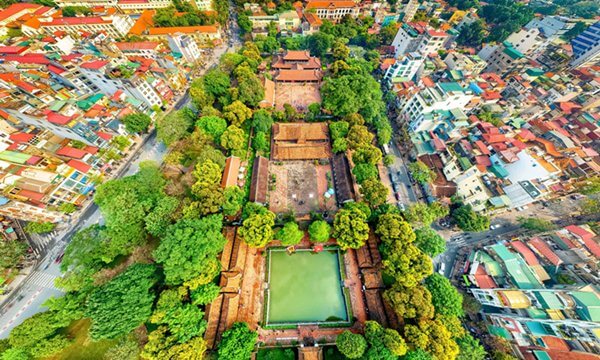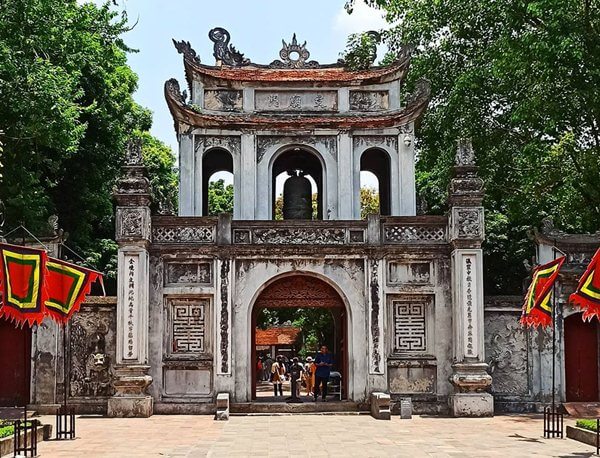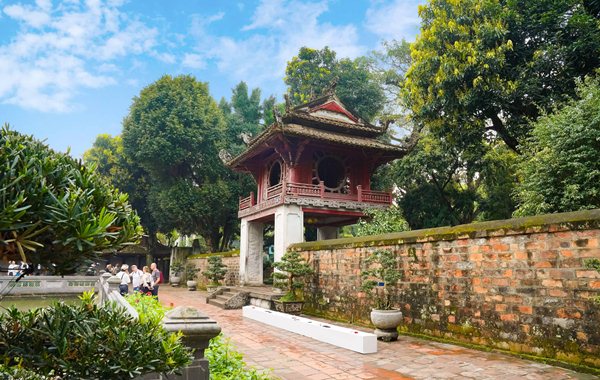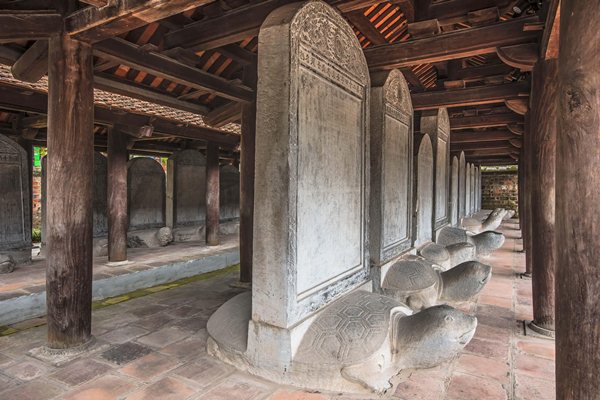The Temple of Literature is the typical relics in the system of tourist destinations in Hanoi. With important historical and cultural significance, The Temple of Literature become one of the special national monuments of Vietnam.

Van Mieu Quoc Tu Giam
Having a convenient location at the intersection of 4 central streets of Dong Da district, the Temple of Literature keeps the mark of the ancient cultural history of thousands of years in the heart of the capital.
- Address: 58 Quoc Tu Giam Street, Van Mieu, Dong Da District, Hanoi, Vietnam
- Opening hours: 8:00 am – 6:00pm, every day
- Entrance ticket: 30,000 VND/adult, free for children under 15 years old
- The different name: Văn Miếu, Quốc Tử Giám Văn and Miếu Quốc Tử GiámVan (in Vietnamese); and the Temple of Literature or the Literature Temple (in English)
- Phone: +8424 3747 2566
- Website: http://vanmieu.gov.vn
1. The history of The Temple of Literature
Constructed in August 1070 under King Ly Thanh Tong (1023 -1072), the Literature Temple had the function of worshiping the saints of Confucianism. Then, it became the first royal school where the princes and mandarins’ children studied.
The first pupil of this royal school was Prince Ly Can Duc, who became the King Ly Nhan Tong (1060-1128) later. In 1076, Ly Can Duc, who was this first student of this place, set up a teaching school beside the temple after ascending the throne. The school only reserved for children of kings and mandarins, so it was named Quoc Tu Giam.
In 1253 under King Tran Thai Tong (1218-1277), Quoc Tu Giam School renamed “Quốc học viện” (the National Academy). At this time, the school was expanded and accepted the children of the public to study, but just choose students with academic excellence.
During the reign of King Tran Minh Tong (1300 – 1357), Chu Van An was a leader of the school, as of today’s principal. He was responsible for managing all activities of Quoc Tu Giam and directly teaching Prince Tran Vuong.
In 1484, King Le Thanh Tong (1442-1492) organized an examination and erected the stele of those who passed the doctoral exam. By the time of Nguyen (1802 – 1945), Quoc Tu Giam school was built in Hue City, since then this school in Hanoi was renovated into the Temple of Literature and preserved until nowadays.
2. The architecture of the Temple of Literature
The complex of the Temple of Literature is a large rectangular land with an area of 54,331m2, bearing the architecture of the early Nguyen Dynasty (because the Nguyen Lords and Kings had restored it). And, all the buildings of Van Mieu campus are surrounded by four solid brick walls.
The Temple of Literature has a layout according to groups with the North-South axis. From the big entrance, there are four pillars. Going inside the area of Quoc Tu Giam, you will see the following buildings on one line. They are Dai Trung Gate – Khue Van Cat (Five Star Pavilion) – Lake – Dai Thanh Gate – Dai Thanh Temples – Thai Hoc Gate – Thai Hoc Buildings (School rooms).
3. The Guide to visit the Temple of Literature
To visit the Temple of Literature, you should follow the guides in the sequence below.
3.1. Ho Van (Literature Lake)
Ho Van locates in front of the gate of Van Mieu (opposite to another side of the Quoc Tu Giam road). Ho Van was a big lake belonging to the system of the Temple of Literature.
In the lake, there is a small island used to be a place for the literature talents exchanging poems.
However, with the change of history, this Literature Lake has a small area of 12,200 square meters. However, with great historical and cultural significance, Hanoi City has restored Ho Van and preserve it well. Thus, it is now a beautiful site you can visit when you come to the Temple of Literature.
3.2. Van Mieu Gate

Van Mieu Gate is the outer three-door one of the relic with 2 levels. The upper floor has three words: “Văn Miếu Môn” in ancient Han characters.
In front of this gate are the four central pillars and two Ha Ma steles on either side. It is said that in the past, whether it was a royal people when passing Van Mieu, they had to walk at least from the stele of Ha Ma to the other, and then could go on again.
That feature shows how significant roles of the Temple of Literature is.
3.3. Dai Trung Gate (the Great Middle Gate)
Dai Trung Gate is the second one of the Temple of Literature that behind the main gate.
The Great Middle Gate consists of 3 compartments built on a high brick foundation and covered with half-circle tiles in the style of ancient communal houses.
In front of and behind the Great Middle Gate, there are large spaces full of trees, lakes, and long pathways, creating a sense of solitude, elegance, and tranquility of the cultural capital.
3.4. Khue Van Cac (Literature Pavillion)

Khue Van Cac is a square floor with eight roofs, nearly 9 meters high. This building has two levels of roofs, including 4 lower and 4 rooftops.
This construction was built in 1805 under the Nguyen dynasty. All the pavilion stands on a square ground with a width of 6.8 meters.
The architecture of Khue Van Cac is unique, which has the under part made of stone, and upper made of wood. The four sides of the second floor have circular windows like the sun and the shining star.
Khue Van Cac also was the place where Confucian scholars gathering to comment on the literature of scholars who won the contest.
With its unique architecture and symbolic meaning of Vietnamese literature and education, Khue Van Cac has become the symbol of Hanoi Capital.
3.5. Thien Quang Lake and Doctor’s steles

Thien Quang Lake has a square shape with the meaning of symbolizing the ground. Thien Quang Lake is right behind Khue Van Cac which represents heaven. These two symbols imply that all the quintessence of heaven and earth gathers at the cultural and educational center in the ancient Thang Long Citadel (former name of Hanoi).
On the two sides of Thien Quang Lake are two lines of stone steles called doctoral steles. Each stone stele is a unique work of art, intricately sculpted and has great spiritual significance. 82 doctoral steles were built on the backs of 82 greenstone turtles, which have recognized and honored 82 valedictorians in the royal exam of the ancient Vietnamese feudal dynasties.
On each stele, there is information about the doctor who passed the exam of that year, and full reports about the exam department, the dynasty, the philosophy of education at that time.
These steles are a very unique point in Vietnam and the world that makes the doctor steles become the most valuable sightseeing relic in the whole of the Temple of Literature.
3.6. Dai Thanh Gate and the Temple Buildings
Dai Thanh gate also has 3 compartments. When stepping through the Dai Thanh gate, visitors will reach a vast courtyard paved with the bricks from Bat Trang Pottery Village, leading to the middle area of the Quoc Tu Giam relic. That is Dai Bai Duong – the main temple for worshipping.
Dai Bai Duong consists of 9 compartments, but only 2 sidewalls, and the front and back sides are empty. This building is the place of worship in the ancient spring-autumn rituals. In Dai Bai Duong, only the center in the middle is a shrine, and the rest are empty.
Thuong Dien (the Upper Temple) is right behind Dai Bai Duong, and it has a similar scale to Dai Bai Duong. Between these two works is a transitional building to connect two temples.
Thuong Dien consists of 9 compartments. Thuong Dien is the place to worship the ancestors of Confucianism. The middle room is dedicated to worshiping the Su Confucius (Khong Tu), and the other parts worship other students of Confucius.
Behind the main temples are the other buildings that have been restored to worship. The last buildings are used to display the images of traditional education, and respect for the national talent in the recent periods.
7. Notes to visit Van Mieu Quoc Tu Giam
When visiting the Temple of Literature, you should pay attention to the following points:
- Wear polite, neat, and clean clothing
- Not wear hats or smoke
- Not carry inflammable and explosive materials in the area of the Temple of Literature
- Burn only one incense stick when you want to offer incense at the right place
- Go softly and keep silent
- Protect the landscape and environment clean
- Not do superstitious activities, cheating, gambling in the Temple of Literature
- No harm to artifacts, not write, draw, stand up or rub turtle’s heads, doctor’s stele and other exhibits
What you keep in mind
According to the experience of visiting the Temple of Literature, this site takes you around 1 – 2 hours to explore this monument. Therefore, you should have a schedule to combine other attractions on a full-day Hanoi trip to explore after spending time at Quoc Tu Giam, such as visiting Hanoi Railway Station, Hoan Kem Lake, Hoa Lo Prison, Hanoi Flag Tower, and Hanoi Old Quarter.
If you have the opportunity to visit Hanoi, please remember to travel to this place. Then, you will see the beautiful buildings and know the spirit of the education tradition and respect for talents in Hanoi as well as in Vietnam.